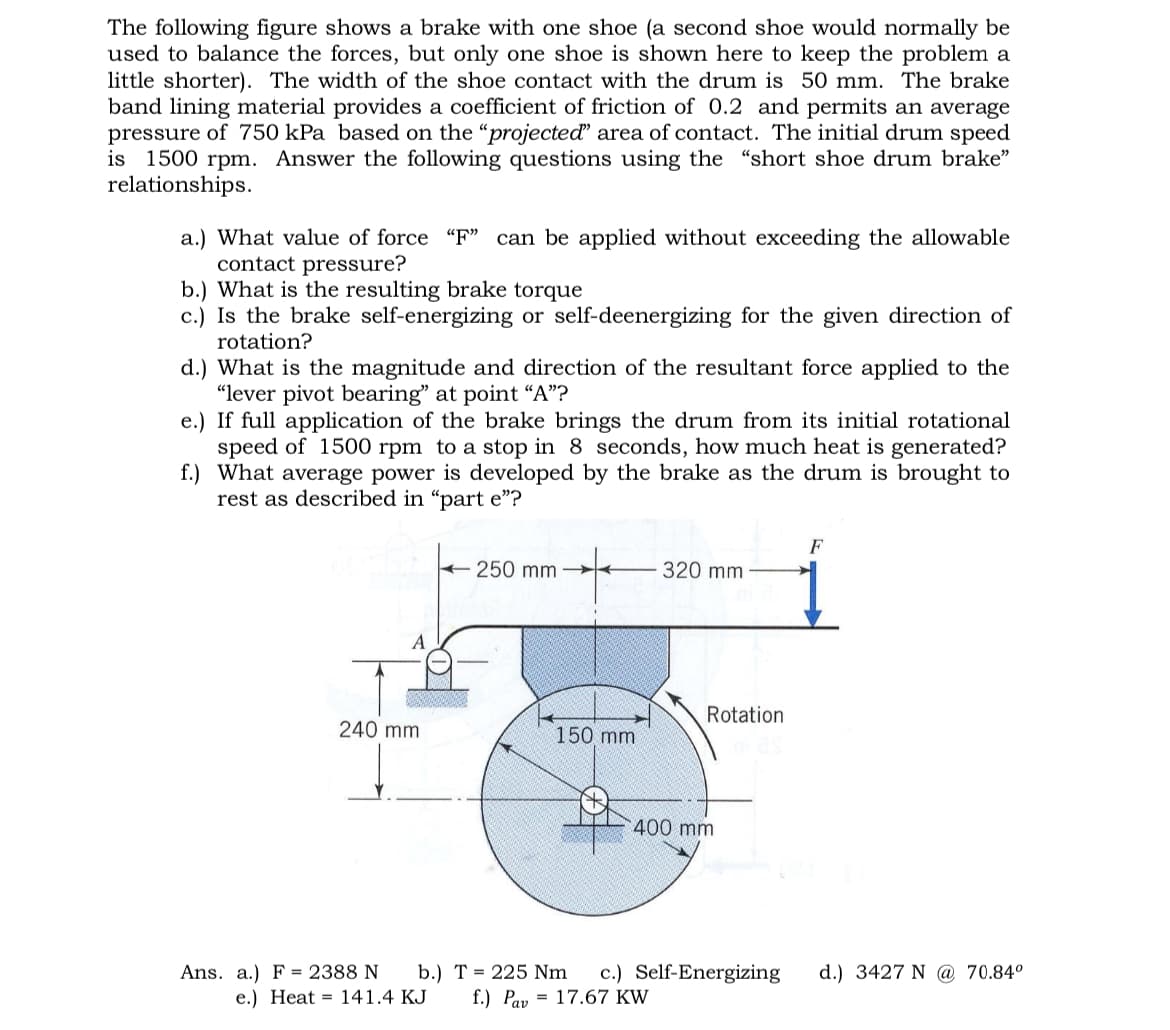The following figure shows a brake with one shoe (a second shoe would normally be used to balance the forces, but only one shoe is shown here to keep the problem a little shorter). The width of the shoe contact with the drum is 50 mm. The brake band lining material provides a coefficient of friction of 0.2 and permits an average pressure of 750 kPa based on the "projected" area of contact. The initial drum speed is 1500 rpm. Answer the following questions using the "short shoe drum brake" relationships. a.) What value of force "F" can be applied without exceeding the allowable contact pressure? b.) What is the resulting brake torque c.) Is the brake self-energizing or self-deenergizing for the given direction of rotation? d.) What is the magnitude and direction of the resultant force applied to the "lever pivot bearing" at point "A"? e.) If full application of the brake brings the drum from its initial rotational speed of 1500 rpm to a stop in 8 seconds, how much heat is generated? f.) What average power is developed by the brake as the drum is brought to rest as described in "part e"? A 320 mm 250 mm Rotation 240 mm 150 mm 400 mm F c.) Self-Energizing d.) 3427 N @ 70.84° 17.67 KW b.) T 225 Nm f.) Pav Ans. a.) F 2388 N e.) Heat 141.4 KJ
The following figure shows a brake with one shoe (a second shoe would normally be used to balance the forces, but only one shoe is shown here to keep the problem a little shorter). The width of the shoe contact with the drum is 50 mm. The brake band lining material provides a coefficient of friction of 0.2 and permits an average pressure of 750 kPa based on the "projected" area of contact. The initial drum speed is 1500 rpm. Answer the following questions using the "short shoe drum brake" relationships. a.) What value of force "F" can be applied without exceeding the allowable contact pressure? b.) What is the resulting brake torque c.) Is the brake self-energizing or self-deenergizing for the given direction of rotation? d.) What is the magnitude and direction of the resultant force applied to the "lever pivot bearing" at point "A"? e.) If full application of the brake brings the drum from its initial rotational speed of 1500 rpm to a stop in 8 seconds, how much heat is generated? f.) What average power is developed by the brake as the drum is brought to rest as described in "part e"? A 320 mm 250 mm Rotation 240 mm 150 mm 400 mm F c.) Self-Energizing d.) 3427 N @ 70.84° 17.67 KW b.) T 225 Nm f.) Pav Ans. a.) F 2388 N e.) Heat 141.4 KJ
Elements Of Electromagnetics
7th Edition
ISBN:9780190698614
Author:Sadiku, Matthew N. O.
Publisher:Sadiku, Matthew N. O.
ChapterMA: Math Assessment
Section: Chapter Questions
Problem 1.1MA
Related questions
Question
Solve and show for given solutions

Transcribed Image Text:The following figure shows a brake with one shoe (a second shoe would normally be
used to balance the forces, but only one shoe is shown here to keep the problem a
little shorter). The width of the shoe contact with the drum is 50 mm. The brake
band lining material provides a coefficient of friction of 0.2 and permits an average
pressure of 750 kPa based on the "projected" area of contact. The initial drum speed
is 1500 rpm. Answer the following questions using the "short shoe drum brake"
relationships.
a.) What value of force "F" can be applied without exceeding the allowable
contact pressure?
b.) What is the resulting brake torque
c.) Is the brake self-energizing or self-deenergizing for the given direction of
rotation?
d.) What is the magnitude and direction of the resultant force applied to the
"lever pivot bearing" at point "A"?
e.) If full application of the brake brings the drum from its initial rotational
speed of 1500 rpm to a stop in 8 seconds, how much heat is generated?
f.) What average power is developed by the brake as the drum is brought to
rest as described in "part e"?
A
320 mm
250 mm
Rotation
240 mm
150 mm
400 mm
F
c.) Self-Energizing d.) 3427 N @ 70.84°
17.67 KW
b.) T 225 Nm
f.) Pav
Ans. a.) F 2388 N
e.) Heat 141.4 KJ
Expert Solution
This question has been solved!
Explore an expertly crafted, step-by-step solution for a thorough understanding of key concepts.
This is a popular solution!
Trending now
This is a popular solution!
Step by step
Solved in 2 steps with 3 images

Recommended textbooks for you

Elements Of Electromagnetics
Mechanical Engineering
ISBN:
9780190698614
Author:
Sadiku, Matthew N. O.
Publisher:
Oxford University Press

Mechanics of Materials (10th Edition)
Mechanical Engineering
ISBN:
9780134319650
Author:
Russell C. Hibbeler
Publisher:
PEARSON

Thermodynamics: An Engineering Approach
Mechanical Engineering
ISBN:
9781259822674
Author:
Yunus A. Cengel Dr., Michael A. Boles
Publisher:
McGraw-Hill Education

Elements Of Electromagnetics
Mechanical Engineering
ISBN:
9780190698614
Author:
Sadiku, Matthew N. O.
Publisher:
Oxford University Press

Mechanics of Materials (10th Edition)
Mechanical Engineering
ISBN:
9780134319650
Author:
Russell C. Hibbeler
Publisher:
PEARSON

Thermodynamics: An Engineering Approach
Mechanical Engineering
ISBN:
9781259822674
Author:
Yunus A. Cengel Dr., Michael A. Boles
Publisher:
McGraw-Hill Education

Control Systems Engineering
Mechanical Engineering
ISBN:
9781118170519
Author:
Norman S. Nise
Publisher:
WILEY

Mechanics of Materials (MindTap Course List)
Mechanical Engineering
ISBN:
9781337093347
Author:
Barry J. Goodno, James M. Gere
Publisher:
Cengage Learning

Engineering Mechanics: Statics
Mechanical Engineering
ISBN:
9781118807330
Author:
James L. Meriam, L. G. Kraige, J. N. Bolton
Publisher:
WILEY